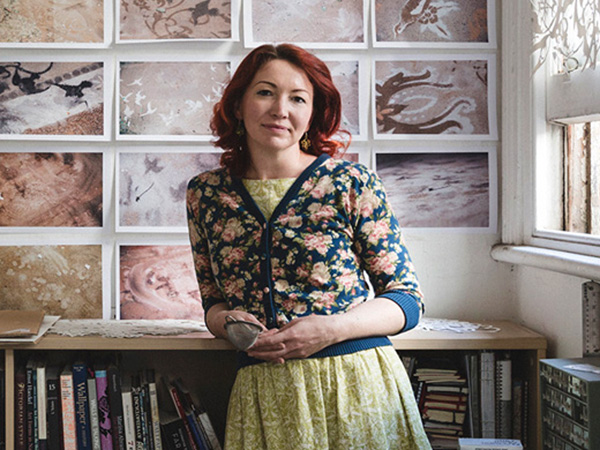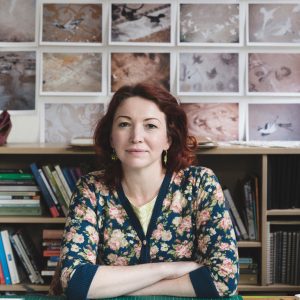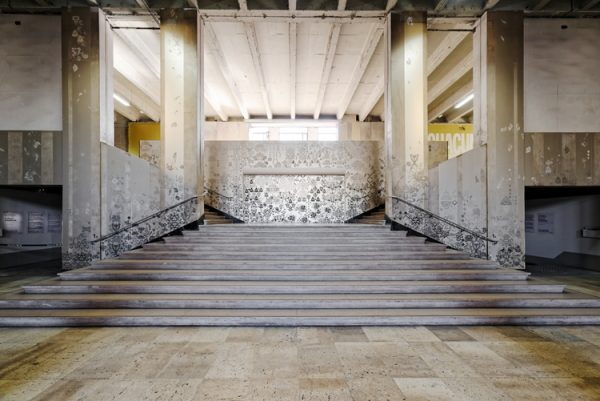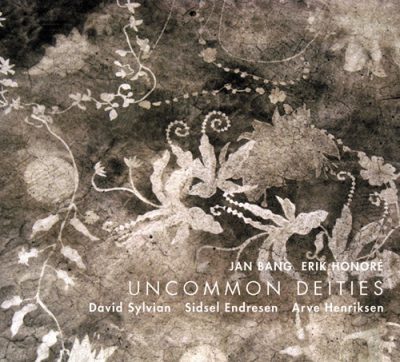
Making Art – Episode 04
Hannah Bertram
Episode Released 24th June 2018
As I leave an artist having recorded a conversation for this podcast series I am trying more and more to listen for an instinctive voice, a clue that might shed some light on the direction this companion article will take. What I guess I’m trying to do is allow something of that first impression, that quiet yet clear inner sense to guide the thoughts that will appear on this page, so that the article becomes more than just a didactic response to that interaction.
To be honest with you, when I started to make this series of podcasts and write these articles I wasn’t really sure what shape this particular thing that I’m making would take. The idea that sits behind it is a simple one. A desire, on my part, to achieve some insight into the process of creating things, artworks, call them what you will because frankly, I’m not sure about my own process. And because I asked that fairly loose question, “What is it to make art?” as a stepping off point on this journey I feel I can engage in a little creative dance here. The truth is, I’m making it up as I go. I know I have a set of skills but “what to do with them?”
As I search for what I am looking for in this series I seem to be getting closer each week to knowing what it will be by developing an understanding of what it will not be. And as I slowly develop a sense of what I am not looking for the process is beginning to change. Whatever these articles and the podcasts become will one day have a quality that I am searching for, although what precisely that quality is I have no idea. I am looking for something and yet I don’t know what that something is.
This of course is an example of Meno’s paradox. Meno, a rich Greek fishmonger (I just made that up, he may well have been a green grocer) asked Socrates how you search for something you are ignorant of. Socrates replied that you can’t search either for what you know nor what you don’t know. One because you know what it is, the other since you don’t know what to look for. And so was born one of philosophy’s great paradoxes. How do you find something new when you don’t know what you’re looking for?
I confess that I don’t know what I’m looking for and yet as I left the studio of the visual artist Hannah Bertram, all I could hear, all I could sense was a quiet voice saying “Its okay not to know.” To be, for a while in a place of discovery that may have no answer. A place that Hannah actively embraces despite at times finding it uncomfortable.

Hannah Bertram in her studio
I met with Hannah in her studio in Elizabeth Street and if I were to describe her to you in a word picture the first word that would come to mind is mercurial. When she approaches, you are aware it is a living thing that takes your hand, a person in “the moment” with a curious mixture of openness, vulnerability and confidence. You feel at once in the presence of someone who is having a life but one for whom having a life means being interested in others and allowing herself to be uncertain. She’s stands straight although not rigid, with a fast, enquiring eye that seems to be always looking for something. Something beyond the obvious. Sharp witted and yet deeply thoughtful, sometimes quick with an answer and at others slowing to think, in some ways she is a paradox herself, a person with whom you know straight away you should expect the unexpected.
As we sat to talk she handed me a list of things she thought we could cover. “I don’t want to waffle on.” I chose to largely ignore it and she later confided that it wasn’t waffle she was worried about. The fluid nature of her practice and her life at this moment means she spends a lot of time not knowing the answers.
“I’m getting better at enjoying it as a part of the process of making work but I must say I find it difficult in life.”
For the past 15 years Hannah has devoted herself to a creative exploration of that most ubiquitous and ephemeral of mediums. Dust. Her work has travelled the world like the dust that is at its heart and over the past 6 years she has split her time between working on her PhD and completing 15 solo shows here, in the US, Asia and Europe with perhaps the biggest at the prestigious Palais de Tokyo in Paris.

Pheonix in Ruins – Palais de Tokyo
“The problem with becoming a mid-career artist in Australia is not so much money, it’s a lack of critical mass. There simply aren’t enough galleries or shows to go round. You end up having to look for opportunities overseas.”
For Hannah, that was as much about finding ways to explore new ideas as it was about showing her wares and to talk with her is to understand that a search for new ideas and a determination to understand the intersection life and art are at the core of her being. As is an acceptance, an excitement even at the notion of a life being a series of ever deepening questions. A gift she credits to her father.
“I remember when I was little, really quite little and I was walking with my father and he was talking about now not being a thing and I remember saying “Yes it is. It’s now.” And dad said “But it isn’t ‘cause it’s just gone.” And I remember being so excited and frightened and intrigued by that idea all at the same time. I feel very fortunate to have grown up with a man who always questioned things.”
A questioning that has stayed with her and in adulthood manifests as a love of poetry and philosophy, something that she sees as nourishment.
“Understanding the human experience helps me make sense of things in life and art. I’m interested in the world more broadly and how those philosophical ideas around the human experience have changed through time and in different societies. It gives you a window into thinking about thinking. And it’s the same with poetry. There are things I think and feel that I can’t articulate to myself, things I can’t say. I find that poetry and philosophy help me understand the truth in my experience and allow me to open that up and expand on it.”
It was that “opening up” that led her to quit her first love, painting, after ten years that just “hadn’t done the thing I wanted it to do. I can’t tell you what it wasn’t doing. I can only tell you it wasn’t doing it.” Instead she started exploring the idea of ephemera, temporary pieces that would allow her to consider art as a lived experience. Slowly work began to emerge that mirrored the constant change that surrounds us in a world that is always moving, a world that is fluid despite our attempts to create certainty and permanence. And she did it using a material that is perhaps our only constant, the apparently worthless stuff from which all life sprang and to which all life, all things will eventually return.
“Initially it was that it was overlooked, discarded material. It’s also specifically about places, although at the same time it isn’t. But it’s changing for me now. It’s become a more complex relationship.”
An understanding of dust as a marker of time was part of her original thinking and her work began to explore that passing of time. When dust settles over our domestic existence it quietly suggests time passed, or alternatively, when it’s removed it creates an illusion of timelessness and Hannah’s work became intentionally designed to decay and exist in fluid states of being and disappearing. Over time this has developed into a deeper investigation of the tension that exists between our own desire for permanence and the inevitability of our mortality.
‘There’s a paradox there that appealed to me. The desire to hold on to things even though it’s futile. Which I understand but there was something compelling about the idea that we attempt to preserve when we know that nothing lasts. Dust was teaching me that that was am idea I was interested in.”
And the works are often beautifully ornate. Dust, this annoying patina of life transformed into objects of richness and beauty.
“Decoration is something that exists, something that has its own agency, it sets things apart as special, we notice the difference. A beautifully cut crystal glass is of more value to us than a plastic cup. It speaks to us differently. But it is a value we place on it and values change.”
By way of explanation she gave me a potted history of lace. Originally labour intensive, made by hand, to wear lace was a sign of wealth and prestige. But the advent of the industrial revolution saw it suddenly being mass produced and while it was still relatively expensive, it was affordable by the middle class. With its lack of exclusivity, so went its value, its cache. And it has slid further down our value scale to a point where we now think of it as simply tacky or at best, quaint. “And yet lace itself hasn’t changed.”
Over a number of years she combined her ideas of decoration, the ambiguity of value and the nature of time and popped them in her “toolbox” slowly deepening her practice. Each work in some way informing the next. “You carry with you the traces of all the work you have done previously. All your thoughts. Ideas that you play with and don’t do anything with often come back. Sometimes years later.”
A breakthrough of sorts came in the mid noughties with a work that had been slowly developed and refined in this way. “An Ordinary Kind of Ornament”, a series of oriental carpets made from dust attracted huge interest. Not just here but overseas. The successful coming together of what Hannah now sees as the second stage of her journey set her on a rapid rise. Shows in New York, Paris, international representation, all the trimmings.

An Ordinary Kind of Ornament
But it came with a cost. For a number of years in Australia she was constantly asked to repeat shows on the same theme and by her own admission she began to feel lost. “I thought, dust carpets, maybe this is it, maybe I’m a one trick pony.”
She settled in to writing a PhD to “Change things up.” “I love teaching and they said if you want to teach you need a PhD so I did the PhD and of course you finish. It was the hardest thing I think I’ve ever had to do and there are no jobs, or they want a Cert 4 and you just…”
The finishing of the PhD led to six months working in a call centre. “I was really struggling to get there and then I decided I could make some work while I was on the phones. I started doing drawings on the back of bills, other minutia. I called it my studio B job.” It was tough period, her daughter left home, her dog died and her marriage of twenty years collapsed. She freely admits finding life a struggle. Even the work stopped providing solace. “I was stuck.”
Having passed through a tough period she has a renewed enthusiasm for creativity and has found that the understanding gained doing the PhD, has deepened her practice yet again, opening doors to new thoughts and helping to clarify old ones. “Heidegger talks about how a work of art is made, from matter comes a form which is placed in a context and fashioned by the artists. Each are indebted to each other. I read that and realised that was what I was doing. For me, if I have an idea then I feel I have a responsibility to look at the material, what it already is, what it’s doing in the world, what associations it has in the world and try not to inflict something on it but let it tell me what it can be. Life is like that. And now I have bigger toolbox. And I might pull something out if it seems relevant. There’s more of an openness to possibility that way. Openness is about going “I’ll start with my first idea, allow it to be disaster and see if there’s anything of interest in it then allow it to go somewhere else.”

Uncommon Dieties -Album cover for David Sylvian
Time marches on and the dust resettles. When I met with Hannah in her studio, she was working on a number of projects, one with a French connection and an installation for the Biennale of Australian Contemporary Art being held in Ballarat in September. And the remnants of her last work, the outline of a grand piano, is still taped to the floor. It’s a template for a recent show in Singapore where she covered the top of a grand piano with a series of flocked frames that held fields of dust. Dust that included some of the ashes of her late uncle Peter. “He liked an event.” Dust, we begin as it and end as it, all part of an ongoing, evolutionary creative conversation.
If anything she has emerged from a tough period less certain about her life, where she’s going, what she’s doing, how she’s going to keep going but more confident and excited by the work. “You want to grow. You’ve always got to question things. That can get you into problematic spaces sometimes, when I fail I fail in the space. It’s hard to be okay with that but it adds a depth to the work. And a depth to living.”
So here I am, trying to grow. And I can tell you it’s painful. Ray has rung four times asking where this article is. It’s 1.30 am on Sunday morning. You may be reading this in a few hours. I can report to you now that it isn’t what I’m looking for. But I have dug into my toolbox and written it. And I’m getting closer. Perhaps next fortnight.
Links
Below you can find links to further reading in reference to the interview.

